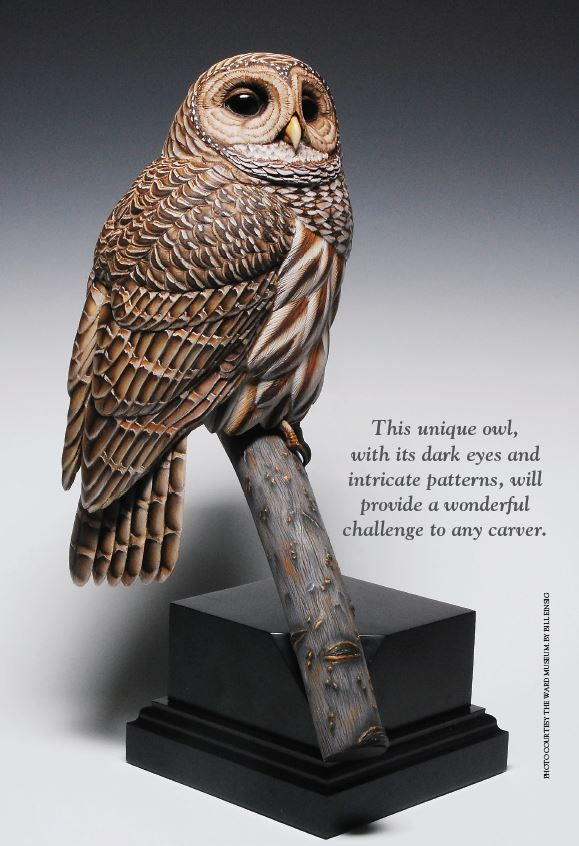The Barred Owl, Part One
This unique owl, with its dark eyes and intricate patterns, will provide a wonderful challenge to any carver.

The barred owl (Strix varia) is one of North America’s larger owls, with adults ranging in length from 16 to 20 inches and in weight from 1 to 2.3 pounds. They have an overall wingspan of 38 to 49 inches and are fairly broad and compact. These inquisitive birds are unique because instead of the golden yellow eyes of many other owls, their eyes are dark brown to almost black. With their large rounded head, broad serene mask, and intricate patterning, the barred owl is a great challenge to any carver or painter.
These owls frequently nest in tree cavities but will also take advantage of old nesting sites of hawks, crows, and even gray squirrels. They normally live in these sites year-round but will occasionally roam short distances, although they do not migrate as some other raptors do. The female lays two to four eggs around mid-April in northern regions and as early as January in the south. The female will brood the clutch of eggs for four weeks while the male keeps her fed. Young owls fledge four to five weeks after hatching. Their varied diet and hunting techniques enable them to take on many small animals, birds, and reptiles, although their prey of preference is the meadow vole. This hunting ability has enabled them to expand their territory into the more western sections of the United States.
When designing this owl, I had a lot of help from my friend Terry at Blue Ribbon Bases. He and I discussed the size and overall idea of how I would display this bird. He came up with some interesting ideas, and when I received the base that we had chosen, the owl just took on a life of its own. Normally I do not use a blacked-out base, but I really wanted the viewer to see just the owl. Even though the base is elegant, it still allows the bird to shine. I used all hand tools from rough-out to final shaping. That approach takes a little longer, but it’s my preferred method with owls.
This article is from the Fall 2012 issue. For more information on our issues, check out our issues page.
Read NextDemonstration: Carver's Block
YOUR RECENTLY VIEWED ARTICLES
Free tutorials, expert tips, exclusive partner offers, and more straight to your inbox!
Cheryl Y
Aug 16, 2016
I would love to try to carve this beautiful Barred Owl. My only problem is I would have to buy the 2012 issue. For some reason I though this was a free pattern?? My loss! But thank you for the beautiful picture and story..
Report Inappropriate Comment
Are you sure you would like to report this comment? It will be flagged for our moderators to take action.
Thank you for taking the time to improve the content on our site.



